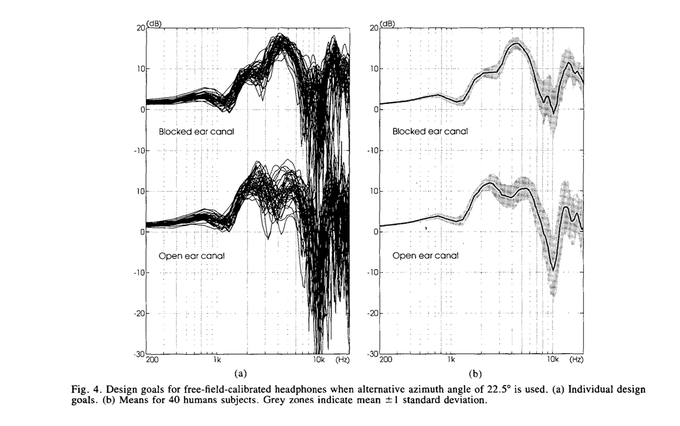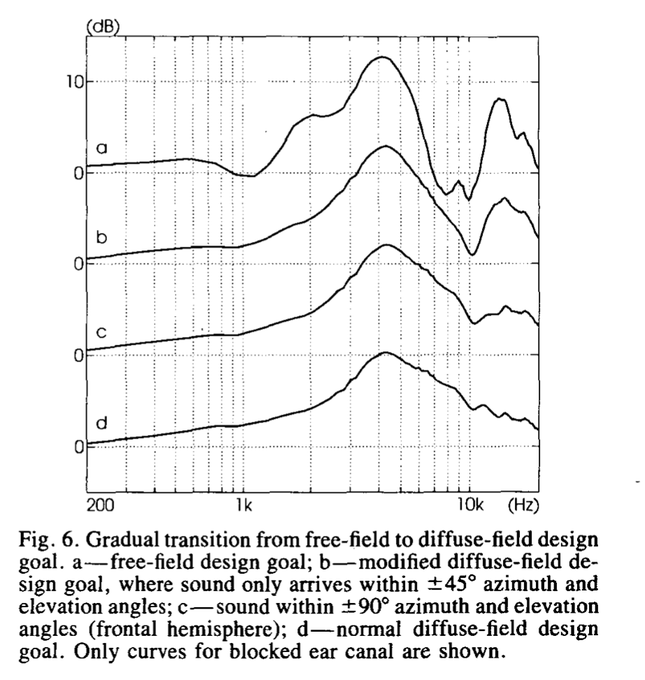-
WANTED: Happy members who like to discuss audio and other topics related to our interest. Desire to learn and share knowledge of science required. There are many reviews of audio hardware and expert members to help answer your questions. Click here to have your audio equipment measured for free!
You are using an out of date browser. It may not display this or other websites correctly.
You should upgrade or use an alternative browser.
You should upgrade or use an alternative browser.
The Etymotic Target (R.I.P. Harman)
- Thread starter Sharur
- Start date
- Joined
- Jan 23, 2020
- Messages
- 4,336
- Likes
- 6,705
Absolutely. It's an even easier decision with speakers since comfort doesn't matter.
This is how I've purchased my last 5 speakers, and it's been a home run every time.
Sharur
Senior Member
- Joined
- Apr 10, 2021
- Messages
- 476
- Likes
- 214
- Thread Starter
- #343
I understand that Harman target for speakers is anechoically flat. The reason I brought up the image you replied to earlier was because the Harman headphone target is basically the "subjectively-preferred steady state room curve target" for speakers. @pozz said people want neutral speakers, and therefore, want neutral headphones. If neutral is anechoically flat placed in a well-treated room, that is not the preferred response in either speakers or headphones based on that image.@amirm, I think it could be very valuable to do a video about the difference between in room measurements and anechoic measurements. I've lost track of how many times I've seen someone post a downward sloping in room figure to make the point that "see, Harman target is not flat". We even have very good engineers that seem to have this same misunderstanding. It's obviously a very common confusion.
Last edited:
ER4XR's measurements are weird the THD numbers are all over the place. I've noticed many don't even show Etymotic's own THD sheet if the unit is 0.3 ~ 0.7% at 1KHz.But I do agree that the ER4XR 80 dB measurement here is sus. I'm not sure why the ER2SE is so much lower if insertion is the same.
I understand that Harman target for speakers is anechoically flat. The reason I brought up the image you replied to earlier was because the Harman headphone target is basically the "subjectively-preferred steady state room curve target" for speakers. @pozz said people want neutral speakers, and therefore, want neutral headphones. If neutral is anechoically flat placed in a well-treated room, that is not the preferred response in either speakers or headphones based on that image.
I'm amazed you guys still haven't figured this out after 18 pages. The Harman study indicates that a speaker that measures anechocially flat (so if you took the speaker out in your yard and measured it, the response would be flat) and have even dispersion characteristics, will be preferred by the majority of listeners in a normal listening room (so in average Joe's living room).
Why is this difficult to accept or understand?
Sharur
Senior Member
- Joined
- Apr 10, 2021
- Messages
- 476
- Likes
- 214
- Thread Starter
- #346
Because that's not what the image indicatesI'm amazed you guys still haven't figured this out after 18 pages. The Harman study indicates that a speaker that measures anechocially flat (so if you took the speaker out in your yard and measured it, the response would be flat) and have even dispersion characteristics, will be preferred by the majority of listeners in a normal listening room (so in average Joe's living room).
Why is this difficult to accept or understand?
Because that's not what the image indicates
Which image specifically?
This one? This is from a study where those who participated were allowed to use tone controls to adjust the sound to their liking. Untrained listeners wanted more bass and treble than a anechoically flat speaker would give, while trained listeners are pretty much on target, as is the average between them. Other studies has shown that neutral speakers with extended (not necessarily elevated) bass response are typically preferred.
A neutral speaker with the ability to adjust the low end (for instance via a subwoofer with a volume control) would likely yield a satisfactory result to most audiences.
- Joined
- Jan 23, 2020
- Messages
- 4,336
- Likes
- 6,705
It's important to differentiate between measured response and perceived response. The graph posted in your video is a response measured by a microphone. That response includes the bass/mid waves reflecting off the back walls and front walls and then hitting the microphone. This is not the way our brain hears and determines what sounds "neutral". Our brain "hears through the room" and uses the anechoic direct on axis sound to determine whether or not the sound is neutral. The microphone measures a tilted response, but only because it's dumb; our brain hears a flat line, because it (correctly) identifies that the direct sound is flat outside of the room's influence("hearing through the room").I understand that Harman target for speakers is anechoically flat. The reason I brought up the image you replied to earlier was because the Harman headphone target is basically the "subjectively-preferred steady state room curve target" for speakers. @pozz said people want neutral speakers, and therefore, want neutral headphones. If neutral is anechoically flat placed in a well-treated room, that is not the preferred response in either speakers or headphones based on that image.
This applies to headphones because Harman started their headphone curve by targeting the perceived response, not the measured response. In other words, they didn't start by targeting the sound of a downward sloping line, they started by targeting the sound of a flat line, which just so happens to look slanted when you try to measure it outside of an anechoic chamber. Bass level does seem to be a matter of taste that sometimes deviates from ultimate neutrality, but it's important to recognize that the Harman loudspeaker target itself does not actually call for elevated bass.
I really do think Amir should do a video on this, as it's a very common misunderstanding, and I can understand why.
That said, it's also my understanding that Harman only started with the curve that best approximated the sound of a speaker that measures flat(anechoically), but have since deviated from that by adding extra bass. I think we kinda agree there.
Also important to reemphasize that curves y'all posted are not true "targets", as they only exactly apply for that particular room, at that particular listening distance, with those particular speakers. Because all rooms are different, there can be no in room target. The only true "Harman target" is a flat line, measured anechoically.
Last edited:
PappaWheelie
New Member
"Velvety" is the best way I can describe the exceedingly pleasurable bass fidelity of ER4, ER6i, and ER4SR earphones. Good 5-string bass material ("good" in terms of audio signal, if not lyrics) like Lucky Peterson's Wash My Back on his Lifetime album showcase the delightful "truth" of fidelity and coherency in the low 30 Hz region that most stereo loudspeakers have great difficulty approximating, if even reproducing at all. The use of EQ to "help" only adds incoherency, as do ported stereo speakers.ER2SE is very similar to ER4SR bass so I'll share my experience. I was listening to ER4XR for a few hours before getting ER2SE and it took me a few hours or so to fully adjust to flat bass having never experienced it and there was no going back to ER4XR. It sounds so incredibly deep and lifelike. ER4SR nor ER2SE lack bass.
Last edited:
Hi guys,
as I love the sound of Etymotic in-ears (hf5 & ER3SE) I would like to calibrate my Shure SE425 with AutoEQ to the Etymotic target curve. Is the Etymotic target curve available as csv file somewhere? Or as plain numbers?
Thanks
Julian
as I love the sound of Etymotic in-ears (hf5 & ER3SE) I would like to calibrate my Shure SE425 with AutoEQ to the Etymotic target curve. Is the Etymotic target curve available as csv file somewhere? Or as plain numbers?
Thanks
Julian
MrBrainwash
Member
- Joined
- Oct 23, 2020
- Messages
- 62
- Likes
- 43
What do you guys think about doing equalization to etymonic target curve for OE headphones?
I did some adjustments on ready presets for my headphones. Not sure if I did it right but I like the effects, and headphones sound more neutral to my ears. I left one filter turned off for bass boost if I will need it.
I did some adjustments on ready presets for my headphones. Not sure if I did it right but I like the effects, and headphones sound more neutral to my ears. I left one filter turned off for bass boost if I will need it.
Interesting thread (Twitter):


This confirms basically what is going on here: Harman is an analogue of the average HRTF of many individuals and in general people will prefer it because it conforms to their HRTF on average. That is the stuff happening mids and above. Bass is more subjective. IMO bass deviations may be discounted a bit and sub-bass reproduction should be tested more if possible. So it is neutral in regard to a spread of average listeners. The treated room stuff can eventually be discarded. The free-field specific HRTF reproduction (with cross-mix) will eventually be the most "realistic" sound for headphones regardless of how speakers should sound in a room of any kind. All of this can be achieved with active EQ/DSP/crossfeed HRTF simulation. Apple may have been on to something with their Max design of a literal flat-output headphone to which an HRTF correction could be applied (think of people going to Apple store to get their ears scanned and mapped with lidar/sonar type feedback). With the events of the past years this probably fell through and now we are again in another dark age reminiscent of the various starts and stops of 3D technology which must inevitably triumph as well.


This confirms basically what is going on here: Harman is an analogue of the average HRTF of many individuals and in general people will prefer it because it conforms to their HRTF on average. That is the stuff happening mids and above. Bass is more subjective. IMO bass deviations may be discounted a bit and sub-bass reproduction should be tested more if possible. So it is neutral in regard to a spread of average listeners. The treated room stuff can eventually be discarded. The free-field specific HRTF reproduction (with cross-mix) will eventually be the most "realistic" sound for headphones regardless of how speakers should sound in a room of any kind. All of this can be achieved with active EQ/DSP/crossfeed HRTF simulation. Apple may have been on to something with their Max design of a literal flat-output headphone to which an HRTF correction could be applied (think of people going to Apple store to get their ears scanned and mapped with lidar/sonar type feedback). With the events of the past years this probably fell through and now we are again in another dark age reminiscent of the various starts and stops of 3D technology which must inevitably triumph as well.
Let's think about one ear in a room. In a room you could say 4 signals arrive to an ear:
- direct signal from the same side speaker
- direct (but around and through the head) signal from the other speaker
- room signal from the same side speaker
- room signal from the other side speaker
So we're summing these 4 signals for each ear. Assuming excellent speakers, the first signal is fairly neutral. Due to physics, the other 3 signals have at least boosted bass or attenuated mids and treble. In general, bass frequencies in music are mixed at or close to the center, so they are present in both channels. Therefore the sum of these signals must have boosted bass. For each ear.
An ear inside a headphone only hears a direct signal from its own channel. If the headphone is flat, to get the natural bass boosted sound of two speakers in a room we'd need crossfeed signal processing. Or the second best solution, a FR with boosted bass.
- direct signal from the same side speaker
- direct (but around and through the head) signal from the other speaker
- room signal from the same side speaker
- room signal from the other side speaker
So we're summing these 4 signals for each ear. Assuming excellent speakers, the first signal is fairly neutral. Due to physics, the other 3 signals have at least boosted bass or attenuated mids and treble. In general, bass frequencies in music are mixed at or close to the center, so they are present in both channels. Therefore the sum of these signals must have boosted bass. For each ear.
An ear inside a headphone only hears a direct signal from its own channel. If the headphone is flat, to get the natural bass boosted sound of two speakers in a room we'd need crossfeed signal processing. Or the second best solution, a FR with boosted bass.
Similar threads
- Replies
- 0
- Views
- 411
- Replies
- 82
- Views
- 10K
- Replies
- 9
- Views
- 734
- Poll
- Replies
- 34
- Views
- 3K
- Replies
- 3
- Views
- 382

